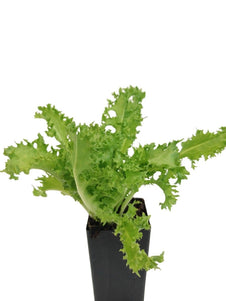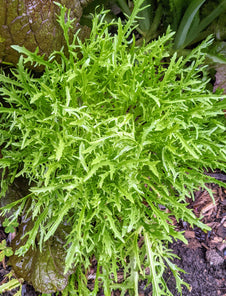



Endive - Salad King
Endive - Salad King

- In stock, ready to ship
- Inventory on the way

Usually available: All year
Life cycle: Annual
Height: 30 - 40cm
Position: Sun / part shade
Soil preference: Well drained
This is how we pack and send your Herb Plants to all states except TAS & WA
You will receive
- 1 Endive - Salad King Herb Plant in a 50 X 75mm tube - General growing instructions
All of our Herb Plants are grown organically with certified organic potting mixes and fertilisers
Botanical Name: Cichorium endivia
Endive Salad King is a large leafy plant with long crinkly ‘lettuce green’ leaves and a white stem. This is an Heirloom Variety from 1957 and of Italian origin, so it makes an attractive addition to any type of garden. It is related to chicory and has a pleasant and smooth, yet bitter taste. As an ornamental it does very well in cottage and formal gardens, while also performing as an edible plant.
Growing Conditions
Endive Salad King is easy to grow and prefers full sun and light, rich free draining soil. Adequate water is required to keep the leaves from becoming too bitter. As the temperatures increase there is also an increase in the bitterness of the leaves. Water should be delivered to the base of the plant, as letting water run down the stems can cause them to rot where water is trapped at the base. In Australia, the best months to sow seed are Feb to April and Sept to Oct, when soil temperatures range between 15 and 25 C. Endive prefers cooler temperatures and when the weather warms the plant may bolt to seed, although this variety is slower than others to bolt. The leaves may be harvested 95 days after planting. This is a good companion to chervil, sage, beans, brassicas, carrots and cucumbers. However, garlic and onion should be avoided.
Culinary Uses
Endive Salad King has a slightly bitter taste, so often it is preferable to harvest the younger leaves. They can be added to any dish requiring green leafy vegetables, such as salads and stir fries. Salad dressings can help reduce bitterness. Simple uses, like topping grated cheese toasted sandwiches with the leaves, also work well. To reduce some of the bitterness leaves may be blanched for several weeks before picking. Simply tie the leaves together when a rosette begins to form, then cover with a pot for darkness.
All information provided on this website is for informational purposes only. Please seek professional advice before commencing any treatment.





